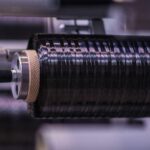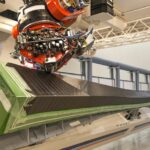Composite materials due to their high strength, low weight and resistance to corrosion have found wide application in various industries, including aviation, automotive and shipbuilding. To ensure the reliability of composite structures, it is necessary to have a good understanding of the processes associated with the accumulation of damage in the material during operation.
The scientists from Perm Polytechnic presented a model and studied the processes of destruction of the layered composite at its subcritical deformation – the stage that comes after reaching the maximum load. The conducted research will allow to predict more accurately the behaviour of composite structures, increasing the safety of technical objects.
When a PCM product reaches critical deformations, its explosive destruction occurs. Such an instantaneous destruction could be observed in 2017 during strength tests of the wing caisson of the MS-21 aircraft in TsAGI. At that time, the loads on the caisson were brought to the limit with “upward bending”. When 131 per cent of the design load was reached, the wing collapsed. However, this does not always happen instantaneously. The material can continue to accumulate damage, moving to a new stage – subcritical deformation. At this stage, there is a gradual decrease in load-bearing capacity and an increase in deformation.
Composites are materials with characteristics that combine two or more components with different physical properties. The main elements are the matrix (main component, resin) and the filler with reinforcement function – carbon fibre. The matrix accepts external loads and transfers them to the filler, redistributes stresses between neighbouring dispersed particles or fibres, protects the filler from harmful environmental effects. The filler plays a leading role in the formation of strength characteristics of PCM.
Researchers from Perm Polytechnic conducted experiments to study the subcritical deformation of layered composites reinforced with carbon fibre. This material is widely used in the creation of lightweight and strong parts, ranging from hockey sticks to aircraft engine blades. To analyse the damage and fracture mechanisms of composites, the method of acoustic emission based on the registration of elastic waves during the destruction of the material structure was used. The research revealed that subcritical deformation of composites is accompanied by intensive destruction of carbon fibres, formation of cracks in the matrix and disruption of bonds between the matrix and fibres.
“In tension, a contraction or otherwise “neck” appears in the middle part of the specimen, which leads to a complex stress state. In this case, standard equipment is not enough to correctly determine the material properties, so we used the VIC-3D non-contact optical video system. With its help it is possible to determine displacements and deformations on the surface of samples. We managed for the first time to build experimental diagrams of composite deformation, where the non-critical stage is realised,” said Elena Strungar, candidate of physical and mathematical sciences, senior researcher of the Centre of Experimental Mechanics of PNIPU Elena Strungar.
The new model of mechanical behaviour of composite materials proposed by the scientists takes into account certain regularities of deformation. This will allow to predict more accurately the behaviour of structures from composites, increasing their reliability and reducing the probability of catastrophic failure of power elements in the design of aircrafts or technical objects.







